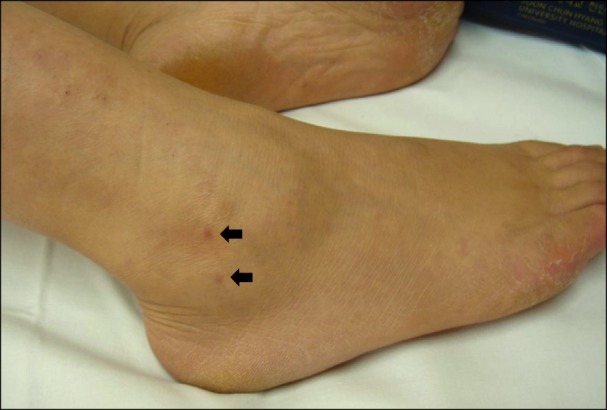Korean J Pain.
2014 Jan;27(1):68-71. 10.3344/kjp.2014.27.1.68.
Development of Complex Regional Pain Syndrome after a Snake Bite: A Case Report
- Affiliations
-
- 1Department of Anesthesia and Pain Medicine, Soonchunhyang University Cheonan Hoapital, College of Medicine, Cheonan, Korea. doc0126@dreamwiz.com
- 2College of Medicine The Catholic University of Korea, Seoul, Korea.
- KMID: 2278205
- DOI: http://doi.org/10.3344/kjp.2014.27.1.68
Abstract
- The occurrence of CRPS after a snake bite was very rare, only two cases were reported worldwide. Here we report a case that the 44-year-old female patient bitten by snakes CRPS type 1 was treated consecutive intravenous regional block, lumbar sympathectomy and antiepileptic drug therapy, also discuss the possible pathophysiology.
Figure
Reference
-
1. Harden RN, Bruehl S, Stanton-Hicks M, Wilson PR. Proposed new diagnostic criteria for complex regional pain syndrome. Pain Med. 2007; 8:326–331. PMID: 17610454.
Article2. Maihöfner C, Seifert F, Markovic K. Complex regional pain syndromes: new pathophysiological concepts and therapies. Eur J Neurol. 2010; 17:649–660. PMID: 20180838.
Article3. Bhattarai B, Shrestha BP, Rahman TR, Sharma SK, Tripathi M. Complex regional pain syndrome (CRPS) type-1 following snake bite: a case report. Nepal Med Coll J. 2008; 10:278–280. PMID: 19558072.4. Ergan SA, Yoleri Ö, Yavaşi S, Ölmez N, Memiş A. Complex regional pain syndrome caused by snake bite: a case report. Turk J Phys Med Rehabil. 2012; 58:69–71.5. de Mos M, Sturkenboom MC, Huygen FJ. Current understandings on complex regional pain syndrome. Pain Pract. 2009; 9:86–99. PMID: 19215592.
Article6. Goebel A. Current concepts in adult CRPS. Br J Pain. 2011; 5:3–11.
Article7. Del Brutto OH, Del Brutto VJ. Neurological complications of venomous snake bites: a review. Acta Neurol Scand. 2012; 125:363–372. PMID: 21999367.
Article8. Chacur M, Gutiérrez JM, Milligan ED, Wieseler-Frank J, Britto LR, Maier SF, et al. Snake venom components enhance pain upon subcutaneous injection: an initial examination of spinal cord mediators. Pain. 2004; 111:65–76. PMID: 15327810.
Article9. Chacur M, Milligan ED, Sloan EM, Wieseler-Frank J, Barrientos RM, Martin D, et al. Snake venom phospholipase A2s (Asp49 and Lys49) induce mechanical allodynia upon peri-sciatic administration: involvement of spinal cord glia, proinflammatory cytokines and nitric oxide. Pain. 2004; 108:180–191. PMID: 15109522.
Article10. Chacur M, Longo I, Picolo G, Gutiérrez JM, Lomonte B, Guerra JL, et al. Hyperalgesia induced by Asp49 and Lys49 phospholipases A2 from Bothrops asper snake venom: pharmacological mediation and molecular determinants. Toxicon. 2003; 41:667–678. PMID: 12727271.
Article11. Seong WK, Chung KT, Kim HH, Park JG, Park YM, Oh HB. Immunological characterization of the venoms from Korean snakes of the genus Agkistrodon (2). Rep Natl Ins Health. 1998; 35:32–33.12. Schinkel C, Gaertner A, Zaspel J, Zedler S, Faist E, Schuermann M. Inflammatory mediators are altered in the acute phase of posttraumatic complex regional pain syndrome. Clin J Pain. 2006; 22:235–239. PMID: 16514322.
Article13. Otero R, Gutiérrez J, Beatriz Mesa M, Duque E, Rodríguez O, Luis Arango J, et al. Complications of Bothrops, Porthidium, and Bothriechis snakebites in Colombia. A clinical and epidemiological study of 39 cases attended in a university hospital. Toxicon. 2002; 40:1107–1114. PMID: 12165312.
Article14. Subedi A, Bhattarai B, Biswas BK, Khatiwada S. Complex regional pain syndrome (CRPS type-1) in an adolescent following extravasation of dextrose containing fluid-an underdiagnosed case. Korean J Pain. 2011; 24:112–114. PMID: 21716610.
Article15. Coderre TJ, Bennett GJ. A hypothesis for the cause of complex regional pain syndrome-type I (reflex sympathetic dystrophy): pain due to deep-tissue microvascular pathology. Pain Med. 2010; 11:1224–1238. PMID: 20704671.
Article16. Lake AP. Intravenous regional sympathetic block: past, present and future? Pain Res Manag. 2004; 9:35–37. PMID: 15007401.
Article17. Tran de QH, Duong S, Bertini P, Finlayson RJ. Treatment of complex regional pain syndrome: a review of the evidence. Can J Anaesth. 2010; 57:149–166. PMID: 20054678.
Article18. Vanos DN, Ramamurthy S, Hoffman J. Intravenous regional block using ketorolac: preliminary results in the treatment of reflex sympathetic dystrophy. Anesth Analg. 1992; 74:139–141. PMID: 1734775.
- Full Text Links
- Actions
-
Cited
- CITED
-
- Close
- Share
- Similar articles
-
- A Case with Ophthalmoplegia Following Snake Bite
- A Case Report of Snake bites During Pregnancy
- A case Report of Hyponatremia Resulting from Treatment of Anaphylaxis and Rhabdomyolysis in a Snake Bite Patient
- Contralateral Mirror Image Spreading in Post-Stroke Complex Regional Pain Syndrome
- A Case of Ischemic Colitis following Snake Bite without Disseminated Intravascular Coagulation (DIC)


